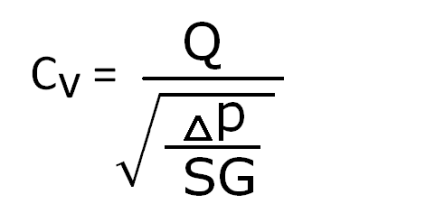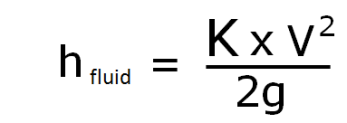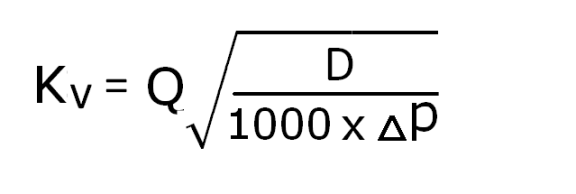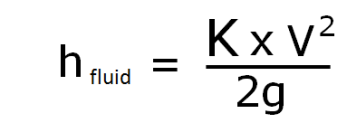Cv and Kv Flow Coefficients
Many manufacturers of control valves choose to publish a Cv flow coefficient or a Kv flow coefficient to describe the flow / pressure loss characteristics of their control valves in a standardized manner.
Cv Flow Coefficients:
A Cv flow coefficient specifies the amount of water at 60°F (15.55 °C) in US gpm that will flow through a valve and produce a 1.0 psi pressure drop. Thus a Cv flow coefficient of 10 indicates that a 1.0 psi pressure drop will occur with a 10 US gpm of water throughput through the valve.
The Cv flow coefficient of a control valve can be calculated from the flow rate and the pressure drop through the valve. For liquids other than water the ratio of the fluid density to the density of water must also be used in the calculation.

Where:
Cv = flow coefficient
Q = flow rate in US gpm
∆P = pressure loss in psi across the valve
SG = the ratio of the fluid density to the density of water
With a known Cv flow coefficient the above formula can be re-arranged to calculate the pressure loss for a particular flow rate thus:

Where:
Cv = flow coefficient
Q = flow rate in US gpm
∆P = pressure loss in psi across the valve
SG = the ratio of the fluid density to the density of water
The pressure loss through a fitting or valve may also be calculated from:

Where:
h fluid = head of fluid in ft.
K = flow coefficient of a valve or fitting
V = fluid velocity entering the fitting in ft/s
g = acceleration due to gravity in ft/sec2
also

Where:
P = pressure in psi
h fluid = head of fluid in ft.
D = density of fluid in lbs/ft3
Thus a 1.0 psi pressure drop is equivalent to 2.31 ft head of water at Normal Temperature & Pressure (NTP) or 62.3 lbs/ft3.
When a pipe diameter is known it is possible to establish a flow velocity from the Cv flow coefficient in US gpm for a 1 psi pressure drop. Thus it is possible to calculate an equivalent fitting ‘K’ factor which will produce the same pressure loss as the control valve Cv rating.
Pipe Flow Expert uses the equivalent fitting ‘K’ factor method to model the flow and pressure loss through a control valve where a Cv flow coefficient is used to specify the control valve characteristics.
A change to the pipe diameter would result in a change to the value of the equivalent fitting ‘K’ factor.
Pipe Flow Expert re-calculates the equivalent fitting ‘K’ factor for the current pipe diameter and the fluid density at the start of the solution calculation.
The calculation helper provided on the Cv component dialog uses the flow rate and pressure loss entered by the user, together with the current fluid density to calculate a Cv value to match the specified requirements.
Kv = 0.865 Cv (or more accurately Kv = 0.86497767 Cv)
Kv Flow Coefficients:
A Kv flow coefficient specifies the amount of water at 20°C (68 °F) in m3/hour that will flow through a valve and produce a 1.0 bar pressure drop. Thus a Kv flow coefficient of 10 indicates that a 1.0 bar pressure drop will occur with a 10 m3/hour of water throughput through the valve.
The Kv flow coefficient of a control valve can be calculated from the flow rate and the pressure drop through the valve. The density of the liquid in kg/m3 must also be used in the calculation.

Where:
Kv = flow coefficient
Q = flow rate in m3/hr
∆P = pressure loss in bar across the valve
D = the density of the fluid in kg/m3
1000 = the density of water in kg/m3
The usual arrangement of the formula for calculation of Kv is shown above.
It can be seen that this formula is similar to the one which is used for calculation of Cv values.
With a known Kv flow coefficient, the above formula can be re-arranged to calculate the pressure loss for a particular flow rate thus:

Where:
Kv = flow coefficient
Q = flow rate in m3/hr
∆P = pressure loss in bar across the valve
D = the density of the fluid in kg/m3
1000 = the density of water in kg/m3
The pressure loss through a fitting or valve may also be calculated from:

Where:
h fluid = head of fluid in meters.
K = flow coefficient of a valve or fitting
V = fluid velocity entering the fitting in m/s
g = acceleration due to gravity in meters/sec2
also

Where:
P = pressure in bar
h fluid = head of fluid in meters
D = density of fluid in kg/m3
g = acceleration due to gravity in meters/sec2
When a pipe diameter is known it is possible to establish a flow velocity from the Kv flow coefficient in m3/hr for a 1 bar pressure drop. Thus it is possible to calculate an equivalent fitting ‘K’ factor which will produce the same pressure loss as the control valve Kv rating.
Pipe Flow Expert uses the equivalent fitting ‘K’ factor method to model the flow and pressure loss through a control valve where a Kv flow coefficient is used to specify the control valve characteristics.
A change to the pipe diameter would result in a change the matching equivalent fitting ‘K’ factor.
Pipe Flow Expert re-calculates the equivalent fitting ‘K’ factor for the current pipe diameter and the fluid density at the start of the solution calculation.
The calculation helper provided on the Kv component dialog uses the flow rate and pressure loss entered by the user, together with the current fluid density to calculate a Kv value to match the specified requirements.
1.000 Cv = 1.156 Kv
The user should be aware that the Cv or Kv flow coefficient specifies the flow rate of water for a particular pressure loss.
When the fluid density is greater or less than water, a different flow rate will be required to produce a 1.00 psi or a 1 bar pressure loss through the valve.
CAUTIONS:
Choked Flow:
If the fluid is a gas, when using the Compressible Flow calculation engine, if the pressure drop exceeds the critical pressure ratio when compared to the inlet pressure of the valve then the flow will become choked and it will not be possible to achieve the calculated flow rate. If this occurs, Pipe Flow Expert will warn of a problem in the Result Log (if the Component option to check for choked flow has been selected).
Gas Flow Calculation with the Compressible Flow Calculation Engine (recommend):
Gas systems should generally be solved using the Compressible flow calculation engine, which takes account of the pressure condition at the component and adjusts the density of the gas as appropriate when performing the component pressure loss calculation.
The fluid properties should be defined at the operating temperature for a particular section of the system (while the software adjusts fluid properties for changes of pressure as they are used in calculations, it assumes the temperature of the fluid remains the same and therefore the user must define the fluid properties for the appropriate temperature conditions within the pipe network). The software uses the viscosity of the gas as defined in the current fluid data and this is not adjusted for changes in pressure (pressure changes generally have a small impact on viscosity in comparison to temperature changes). See the section on Working with Compressible Fluids for more information and notes about calculating gas system with the non-compressible calculation engine (even though we recommend you use the Compressible Flow calculation engine to solve gas systems).
Gas Flow Calculation with the Non-Compressible Flow Calculation Engine (not recommended):
If using the Non-Compressible calculation engine, and the fluid zone associated with the control valve does not represent the pressure condition at the outlet of the valve/component, it may be necessary to use an adjusted Cv (or Kv) value for valve selection to take in to account the effect of the gas expansion.
The adjusted Cv (or Kv) value should be based on the Cv or Kv formula for sub critical gas pressure drop.
A simplified version of the Cv formula for sub critical gas pressure drop is shown below:

Where:
Cv = flow coefficient
SCFH = flow rate in ft3/hr (NTP)
Dn = the gas density in lbs/ft3 at 0.00 psig
oF = gas temperature
∆p = pressure loss in psi absolute
po = valve outlet pressure in psi absolute
A simplified version of the Kv formula for sub critical gas pressure drop is shown below:

Where:
Kv = flow coefficient
Q = flow rate in m3/hr (NTP)
Dn = the gas density in kg/m3 at 0.00 barg
oC = gas temperature
∆p = pressure loss in bar absolute
po = valve outlet pressure in bar absolute
Please refer to an appropriate text book for a more detailed formula to take account of piping geometry or gas compressibility, should this be necessary.
Cv / Kv Control valve selection:
The Cv (or Kv) flow coefficient of a control valve is usually stated for the fully open flow condition.
The Cv (or Kv) flow coefficient will be less when the valve is partly closed.
In an actual system it is important to select a control valve which has an appropriate Cv (or Kv) flow coefficient for the actual valve position that will be used. A control valve that is too small or too large will never be able to provide the correct control in a system.
Most control valve manufacturers recommend that you should select a valve where the required Cv (or Kv) value falls between 20% - 80% of the port opening.
Some control valve manufacturers recommend that an allowance of 30% should be added to the calculated Cv (or Kv) flow coefficient to obtain the minimum full flow Cv (or Kv) flow coefficient rating which the selected valve should have (when fully open).
Please check your control valve selection with the control valve manufacturer.

